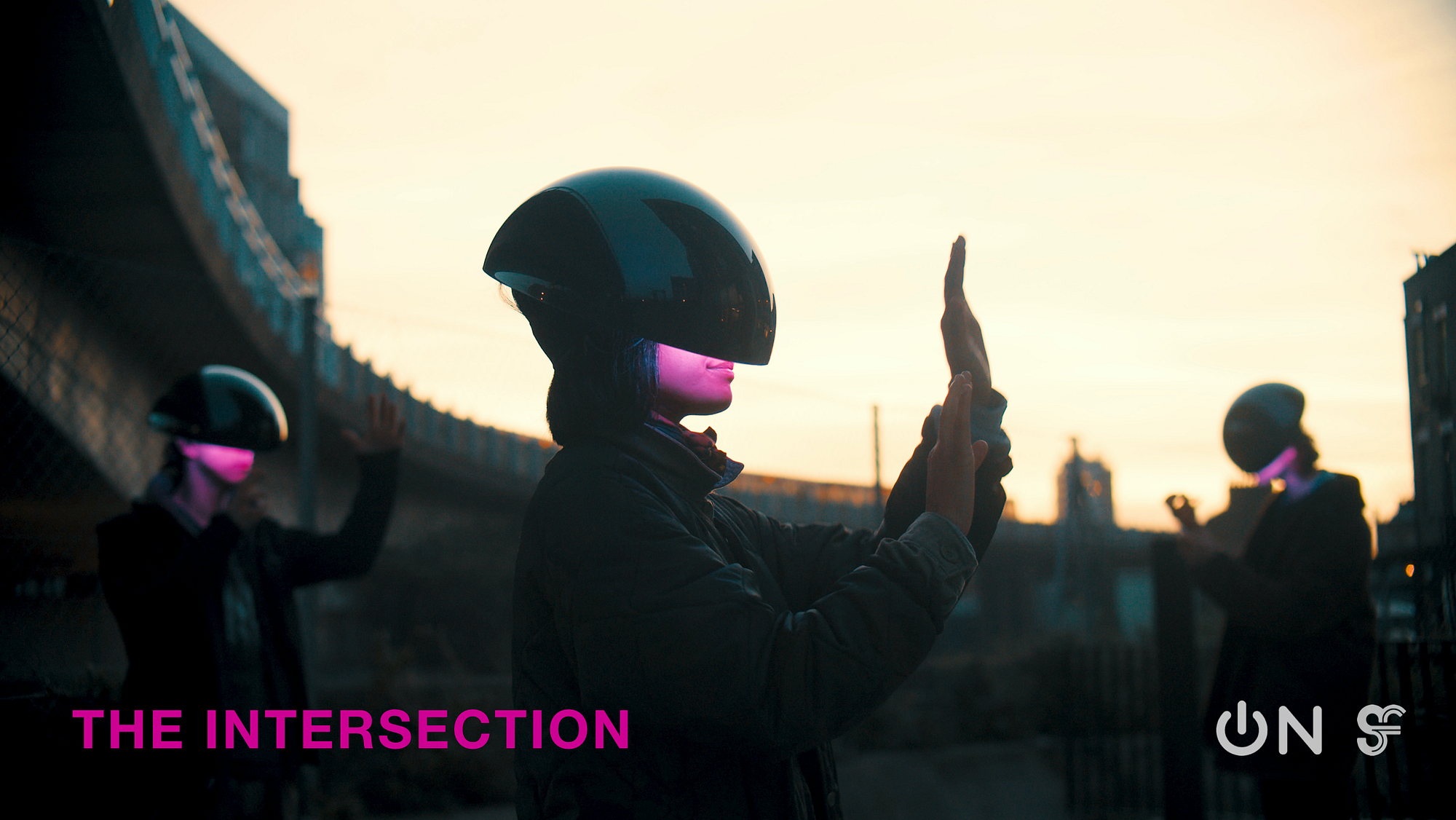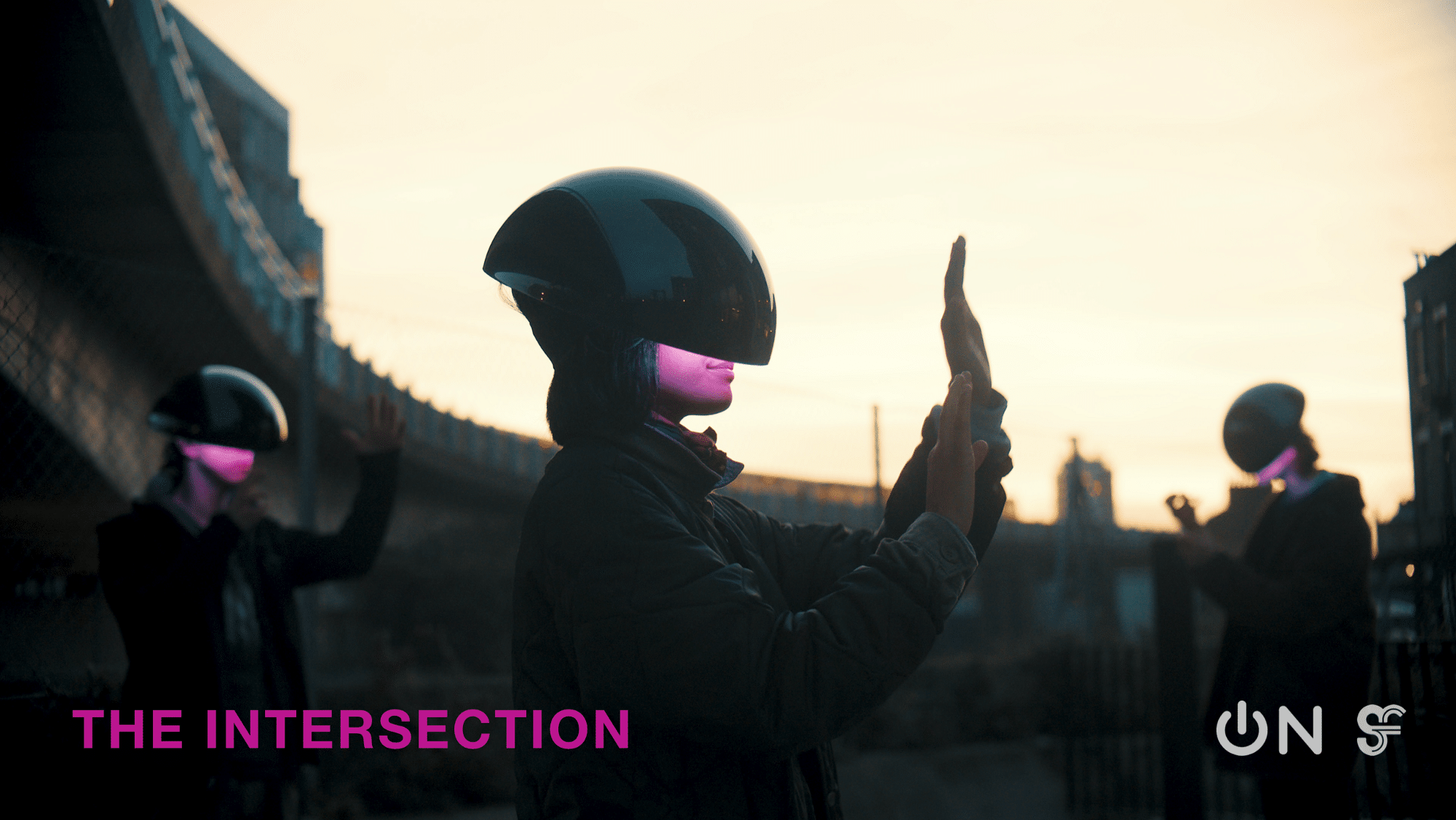
By Julia Solano, Eshanthi Ranasinghe, and Nicole Allred, Exploration & Future Sensing, Omidyar Network
The Intersection, a short film in collaboration with Superflux, creates a hopeful future that reimagines extractive, hyperconnected technology to serve community, support nature, and value human relationships. Watch here.
My low balance of -$1.50 glows red above my wrist as I cross through the turnstile and enter the station. Options to top up via crypto or credit are greyed out on my digital wallet; those accounts are empty. Guess I’m watching the ads today, just like they’re watching me.
As I sit down on the train, images — shoes I’ve always wanted, modeled by my favorite influencers, with payment plans to shrug off my empty bank account — flash before my eyes. There’s no hiding from them — the algorithms track my eye-movement, my heartbeat, my temperature. They know what I want before I do…
Technology is causing our perception of reality — and of each other — to splinter. The same stories and facts can be twisted and contorted to fit a desired narrative depending on which slice of the web we are tuned into. Social media content is engineered for our reaction, “taking our hopes and fears, our pain and suffering and using it as content between ads” (The Intersection); pitting us against each other in a race to the bottom line. We live in fundamentally different worlds — each with its own set of facts — depending on the media we consume.
The average person touches their phone 2,617 times every day, and cellphone addiction (nomophobia: the fear of going without your phone) is rising. This begs the question: Are we driving technology, or is our technology driving us?

What if this reality wasn’t limited to our screens?
Ingestibles, wearables, embeddables; smart homes and peer-to-peer surveillance; the Internet of Things (IoT) and Industrial IoT; 5G; smart cities; facial recognition, temperature checking pandemic drones, and satellite imagery — a new layer of ambient (ever-present, always-on, hyper-connected) technology is seamlessly enveloping the world around us. Ambient data collection and algorithmic decision-making allow our physical environments, like our devices, to be infiltrated with information and metadata constantly gleaned from our search histories, our purchases, our locations, our sleep patterns, our menstrual cycles.
Our physical and digital worlds are developing to become almost indistinguishable. This web of ambient technology is shaping our new reality. Question is, is that what we want?
With the encompassing and interconnected nature of ambient technology, we are barreling towards a society in which each interaction with the physical and digital world is fair game for extraction and exploitation.
This world isn’t science fiction — its creation is in progress, atop a complex web of existing technologies and systems already leveraging the personal data of users.

Omidyar Network’s Exploration and Future Sensing team has been tracking this evolving trend since 2018. Our initial investigations provoked many questions: What could this world look like with a new layer of ambient technology? What currently drives its development and the course it takes? What is the experience of those already commonly marginalized, excluded, and/or discriminated against in current tech and surveillance systems? What might be the experience of immigrants, minorities, elderly, special needs, rural, urban, etc in this world? How could our interaction with technology, government, companies, society, each other change? Will these technology developments only be extractive, or is there a world where they could be supportive, or even regenerative? Is it possible for this world to be designed from a place that acknowledges our interconnectedness and centers diverse perspectives?
Making of “The Intersection”
To provoke the possibilities of this hyper-connected world, we partnered with Superflux, a speculative design and foresight agency. We hoped to provoke imagination about futures that could evolve what we, collectively, would like our relationship with technology to be, as we build the infrastructure, protocols, norms, social structures, and policies, for a technology ecosystem that can be empowering for us all.
“I don’t want the tech we build to consume the world, but to augment and support it. We’re starting to build something new. A new way of networking and connecting. The tech was built from the ground up. To support people, instead of mining them.” — The Intersection
Together we produced “The Intersection”, a short film that explores the future of ambient technology through the lens of four protagonists whose lives have been shaped by the dissonance of extractive technology norms, misinformation, surveillance capitalism, and context collapse:
- Ericka, a young activist whose movement for justice is derailed by a never-ending feed of misinformation and conspiracies concocted to extract data.
- Jake, a journalist whose work is diluted and corrupted by AI systems that helped him prioritize clicks over the truth, taking news out of context and pandering to readers’ “intensely monitored, precisely categorized fears.”
- Amp, a hardware engineer who set out to change the world using technology, only to have her utopian dream shattered by the realization that the only problem she was solving was finding new ways for technology companies to make money.
- Tammi, a climate migrant who became a refugee in her own country because her family refused to evacuate in the face of an impending storm, citing “fake news” reports.


As the film begins, the future of ambient tech is all-encompassing and ever present in every aspect of life. Individually, then together, the protagonists find ways to re-evaluate their relationships with technology — to repurpose and redesign ambient tech to serve their communities, support nature, and value human relationships. They come together to reconcile their differences — illustrating how people can be united by a common purpose, regardless of how different their backgrounds and world views may be. The film ends at a new beginning, open to audiences to shape — where could we head from here? What would we do today, if we knew this is where we were heading?
“We wanted to show in an experiential way, the interconnected nature of the issues present in our world. Whether environmental, social or technological, these domains don’t reside within neat categories, they overlap and intermingle, giving birth to new hybrid forms that are as tricky to define as they are to address”– Anab Jain & Jon Ardern, Superflux.
We hope this film makes the future of ambient technology more tangible, prompts us to investigate our relationship with technology, and encourages us to build towards a more just, pluralistic world that centers the experiences of those most marginalized among us.
Watch the Intersection here. Read our report capturing ambient tech trends, the product of several weeks of ethnographic research and expert interviews, here.

